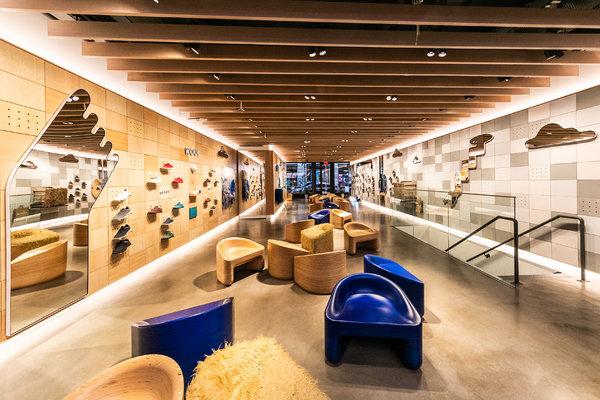
CreditJeenah Moon for The New York Times
People who buy shoes for comfort are cops.
There is really no other explanation. A sparkling, sublime footwear choice is the most expedient way to demonstrate taste. It achieves more per square inch than any shirt could. Whatever you may have to trade in exchange for a shoe with real personality is almost certainly worth it.
I promise, and I have the sore ankles to prove it. The last couple of days, my right outer calf has been throbbing. I am certain this is because of my footwear choices. But though life has crossed me untold times in recent years, I have not yet given up on chasing this particular kind of beauty. Catch me hobbling — and styling — all the way to retirement in Boca.
Determined to prove the viability of this opinion, I skeptically embarked upon a reasonable-footwear doubleheader: Allbirds and Birkenstock, which recently opened a few blocks away from each other on Spring Street.
I went on the day of a dreary rainstorm. Deliberately, I wore my least comfortable rain boots and thin, supportless socks. By the time I hit Spring Street, my feet needed succor.
First came Allbirds, the preferred footwear of Silicon Valley (at least, last year). They are made from merino wool or eucalyptus tree pulp, are machine washable and are studiously unstylish. It is footwear for people who poke around in the code on the websites they visit, and who would prefer not to think too hard about their footwear choices.
Because I don’t live in or near Silicon Valley, I first heard about Allbirds in the Lefsetz Letter, an email sent by a 60-something music-biz hanger-on turned poor-man’s pundit. It is not where one goes to learn about anything au courant.
I sighed deeply, then entered, through doors with handles that were large stubby feet that appeared to be made of compressed wood. Allbirds makes just a few categories of shoes: runners (a clumped silhouette that looks like it was dreamed up in a bootlegging operation), loungers (inoffensive slip-ons), tree toppers (a Chuck Taylor manqué) and skippers (which are, like, the worst Keds).
On foot, the runner ($95) made my foot look pouty, as if it were dipping into the floor. It was an unforgivable silhouette. Most of the store clerks wore the tree toppers — stuffy, but versatile. And the sole, made of sugar cane, was by far the most comforting. (The clerk advised me it was carbon negative, too.)
The loungers ($95) were slightly better, like a slightly steroidal karate slipper. It reminded me of the time a decade ago when I noticed punk dudes on Warped Tour wearing Toms slip-ons (a far worse shoe, and that’s saying something).
Unlike the runner, it was slightly futurist, pointed as if in fast-forward motion. Still, I could see the wool — which is breathable and designed to allow water to pass through — giving each time my foot moved. It felt as if I was going barefoot, but without confidence.
When it comes to open-toe shoes, I adhere to the gospel of Cam’ron, who once barked at Jay-Z on a song: “How’s the king of New York rocking sandals with jeans? Open-toe sandals with chancletas with jeans on.”
This is, I admit, an unevolved position. History gives us our blind spots, and experience allows us to keep them.
And yet here I was, at the Birkenstock store, trying on a pair of Milanos, the ur-Birkenstock model with two cross-straps and one across the back, the stuff of folkies and novelists lounging on the weekend.
This was the first Birkenstock I ever encountered, as a college freshman hanging out with the kid who would become one of my roommates and closest friends. As he played me some Freestyle Fellowship, he wore a pair with chubby wool socks. I was appalled.
I’ve relented slightly since then. I remember telling a girlfriend in the early 2000s that the Gizeh thong sandals for women were due for reappraisal. I’ve seen plenty of handsome men wearing the two-strap Arizonas ($100). These humble German shoes, with the cork insole that molds to your foot, have persevered. And in so doing, thrived.
Anyhow, the Milanos had a sturdy dignity, as if I might wear them to debate metaphysics while chopping wood. I liked them, despite myself. (One tip: If shoppers have to buckle their own shoes to try on, some footstools would help.) I also admired the Arizonas made of foam rubber ($40), made in loud colors for the beaches I’ll never set foot on.
This is the first Birkenstock store in this country, and that it took so long comports with the company’s general reluctance to do anything that might tilt it ever so slightly off path.
But not everything can be controlled top-down. Despite the brand’s best efforts, Birkenstocks are now firmly part of the style universe, and as a result, the company collaborates selectively with the high fashion world.
The cramped second-floor balcony holds the designer collaborations: 10 Corso Como, Rick Owens, Colette, 032c. They’re out of the way, not spotlighted; almost any other company would place these premium items front and center. I was especially impressed with the 032c polyurethane clogs ($200), a slightly tweaked version of the shoe that’s popular with chefs. It was like the child of a Dansko and a Timberland.
I could almost imagine wearing them out of the store. But I had a secret. On an earlier visit, I’d tried on the Rick Owens pair I’d been coveting online — Arizonas in gray calf hair with extended straps ($420). They’re wild and special, and go with nothing. During holiday sale time, I went online and bought them on Farfetch for around half off. No witnesses. Catch me if you can.
Allbirds 73 Spring Street, 888-963-8944; allbirds.com
Birkenstock 120 Spring Street, 646-850-6940; birkenstock.com








